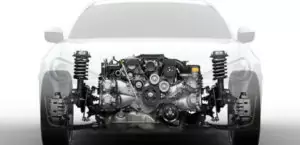The 3.0-liter Renault P9X or 3.0 dci diesel engine was purchased from Isuzu from 2002 to 2010 and was installed on the largest concern models of its time, such as Espace and Vel Satis. This diesel is called Isuzu 6DE1 and is also known as Saab D308L, Opel Y30DT or Z30DT.
In the late 90s of the last century, the American concern General Motors ordered Isuzu to develop a powerful diesel engine for its prestigious European models Saab 9-5 and Opel Vectra. The new motor was introduced in 2001 and was soon put on Renault Espace and Vel Satis. This is an all-aluminum engine with a closed cooling jacket, cast-iron sleeves, a pair of DOHC cylinder heads, a Common Rail Denso fuel system, a variable geometry turbine and a combined timing drive: gears drive the pump and injection pump, and belt camshafts.
Almost immediately there were complaints about frequent overheating of the motor, up to cracking of the block. Official dealers recognized the problem and even changed damaged engines under warranty. In 2005, an updated version of this diesel engine appeared, which does not have such shortcomings.
The engine was installed on:
- Renault Espace 1 (J11) in 2002 – 2010;
- Renault Vel Satis 1 (B73) in 2002 – 2009.
Specifications
| Production years | 2002-2010 |
| Displacement, cc | 2958 |
| Fuel system | Common Rail |
| Power output, hp | 177 (1 gen. P9X 701) 181 (2 gen. P9X 715) |
| Torque output, Nm | 350 (1 gen. P9X 701) 400 (2 gen. P9X 715) |
| Cylinder block | aluminum V6 |
| Block head | aluminum 24v |
| Cylinder bore, mm | 87.5 |
| Piston stroke, mm | 82 |
| Compression ratio | 18.5 |
| Hydraulic lifters | no |
| Timing drive | gears + belt |
| Turbocharging | yes |
| Recommended engine oil | 5W-30, 5W-40 |
| Engine oil capacity, liter | 8.5 |
| Fuel type | diesel |
| Euro standards | EURO 3 (1 gen. P9X 701) EURO 4 (2 gen. P9X 715) |
| Fuel consumption, L/100 km (for Renault Espace 2006) — city — highway — combined |
12.5 7.6 9.4 |
| Engine lifespan, km | ~250 000 |
| Weight, kg | 235 |
Disadvantages of the Renault P9X engine
- Diesel power units from 2001 to 2005 suffered from frequent overheating, up to cracks in the block, subsidence of sleeves, breakthrough of antifreeze into the exhaust manifold, bending of heads, and even rupture of the expansion tank and cooling radiators.
- Camshaft sensors often fail in this engine, especially after replacing the belt, and the mass fuel flow sensor also fails. Its failure is indicated by a sharp drop in engine thrust.
- Other breakdowns: here the EGR valve quickly cokes, the mechanism for changing the geometry of the turbine often wedges and the exhaust manifold burns out.






